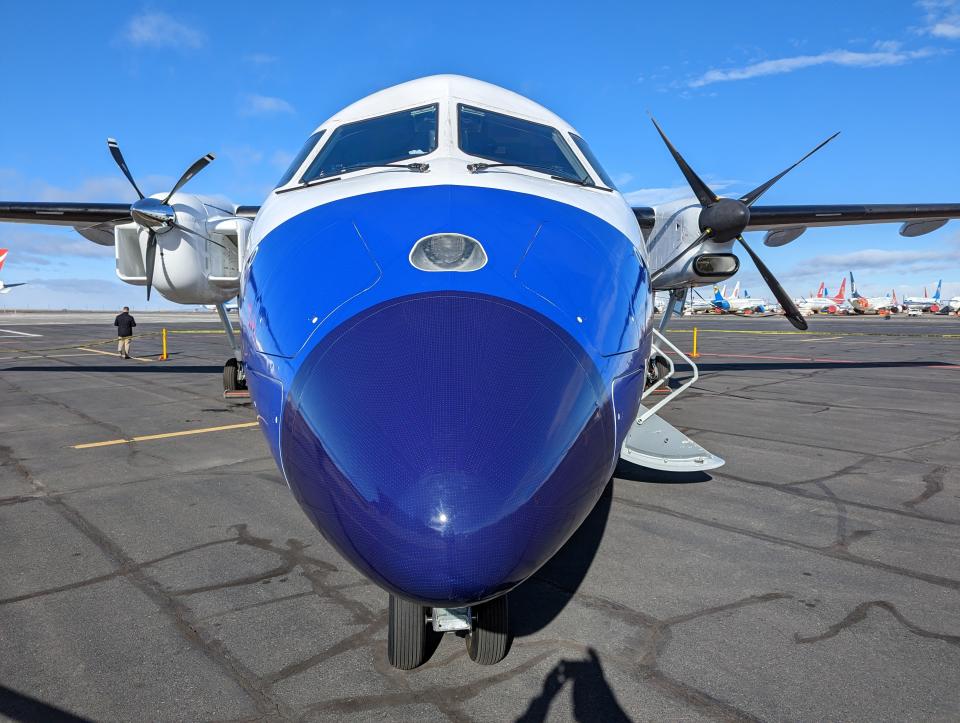Universal Hydrogen takes to the air with the largest hydrogen fuel cell ever to fly
As a Universal Hydrogen-branded plane, equipped with the largest hydrogen fuel cell ever to power an aircraft, made its maiden test flight in eastern Washington, co-founder and CEO Paul Eremenko declared the moment the dawn of a "new golden age of aviation."
The 15-minute test flight of a modified Dash-8 aircraft was short, but it showed that hydrogen could be viable as a fuel for short-hop passenger aircraft. That is, if Universal Hydrogen — and others in the emerging world of hydrogen flight — can make the technical and regulatory progress needed to make it a mainstream product.
Dash-8s, a staple at regional airports, usually transport up to 50 passengers on short hops. The Dash-8 used in Thursday's test flight from the Grant County International Airport in Moses Lake had decidedly different cargo. The Universal Hydrogen test plane, nicknamed Lightning McClean, had just two pilots, an engineer and a lot of tech onboard, including an electric motor and hydrogen fuel cell supplied by two other startups.
The stripped-down interior contained two racks of electronics and sensors, and two large hydrogen tanks with 30 kg of fuel. Beneath the plane's right wing, an electric motor from magniX was being driven by the new hydrogen fuel cell from Plug Power. This system turns hydrogen into electricity and water -- an emission-free powerplant that Eremenko believes represents the future of aviation.
The fuel cell operated throughout the flight, generating up to 800kW of power and producing nothing but water vapor and smiles on the faces of a crowd of Universal Hydrogen engineers and investors.
"We think it's a pretty monumental accomplishment," Eremenko said. "It keeps us on track to have probably the first certified hydrogen airplane in passenger service."
Aviation currently contributes about 2.5% of global carbon emissions, and is forecast to grow by 4% annually.
Still using jet fuel
The Universal Hydrogen-branded plane also relied on jet fuel. Notice the Pratt and Whitney turboprop engine under one wing. Image Credits: Mark Harris
The test flight, which was a success, doesn't mean entirely zero-carbon aviation is just around the corner.
Beneath the Dash-8's other wing ran a standard Pratt and Whitney turboprop engine (notice the difference in the photo above), with about twice as much power as the fuel-cell side. That redundancy helped smooth a path with the FAA, which issued an experimental special airworthiness certificate for the Dash-8 tests in early February.
One of the test pilots, Michael Bockler, told TechCrunch that the aircraft "flew like a normal Dash-8, with just a slight yaw." He noted that at one point, in level flight, the plane was flying almost entirely on fuel cell power, with the turboprop engine throttled down.
"Until both motors are driven by hydrogen, it's still just a show," said a senior engineer consulting to the sustainable aviation industry. "But I don't want to scoff at it because we need these stepping stones to learn."
Part of the problem with today's fuel cells is that they can be tricky to cool. Jet engines run much hotter, but expel most of that heat through their exhausts. Because fuel cells use an electrochemical reaction rather than simply burning hydrogen, the waste heat has to be removed through a system of heat exchangers and vents.
ZeroAvia, another startup developing hydrogen fuel cells for aviation, crashed its first flying prototype in 2021 after turning off its fuel cell mid-air to allow it to cool, and was then unable to restart it. ZeroAvia has since taken to the air again with a hybrid hydrogen/fossil fuel set-up similar to Universal Hydrogen's, although on a smaller twin-engine aircraft.
Mark Cousin, Universal Hydrogen's CTO, told TechCrunch that its fuel cell could run all day without overheating, thanks to its large air ducts.

 Yahoo Autos
Yahoo Autos 
